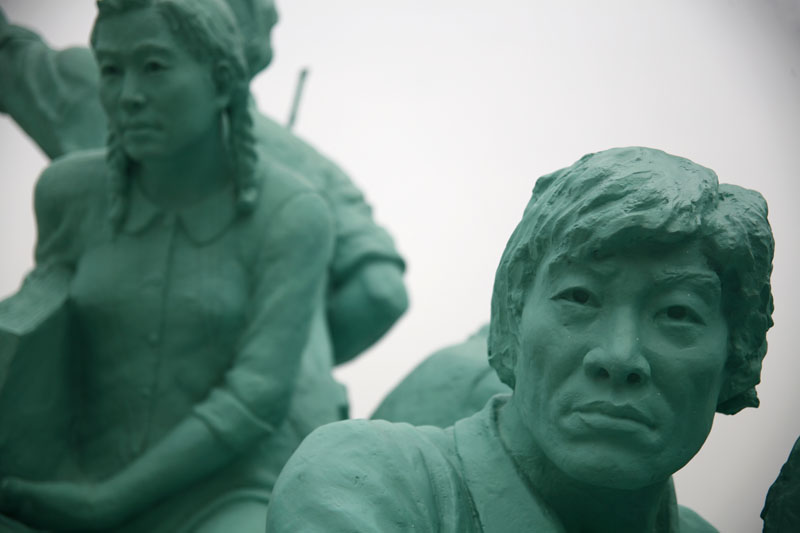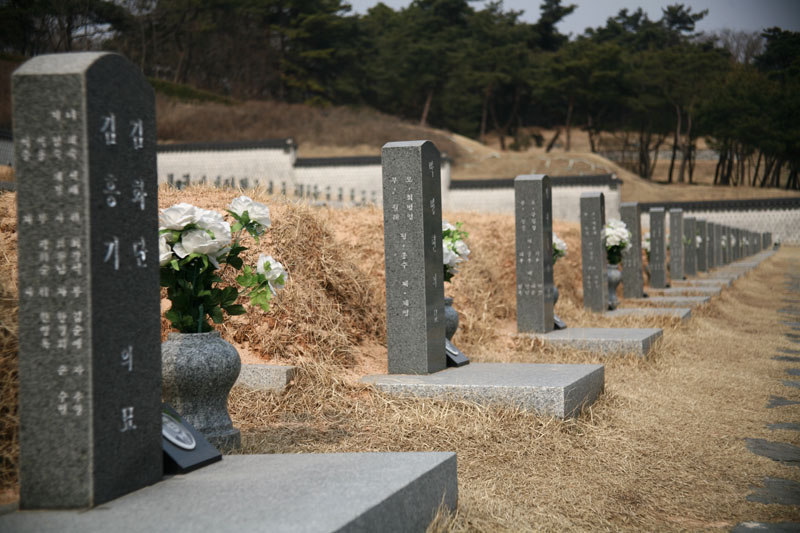Unsung Heroes
Written by Adam Volle
Photographed by Mark Eaton
Originally published July 2013 #137
The issue is a song. Ever since its creation as a funeral song for the heroes of the May 18 Democratic Movement in 1980, “Marching Song for Our Loved Ones” (“임을 위한 행진곡”) has been an anthem for Korean pro-democracy activists. It is traditionally the official song of the annual memorial service, sung by everyone in attendance.
This year, however, the Ministry of Patriots and Veteran Affairs made the decision not to offer the ritual sing-along. Instead, the Seoul Royal Symphony Orchestra and the Incheon City Opera Chorus did the honors. Many believe that President Park Geun-hye’s presence at the service is the reason why organizers gave the song to this group. By doing so, President Park was not put in a position where she was expected to sing along to music she may have found offensive. The resulting controversy has shown that even 33 years after “5/18,” Koreans are still very divided and sensitive about the subject.

That may come as a surprise to foreigners. After all, the story of Gwangju’s resistance against South Korea’s last dictator is commemorated with its own national holiday. But although the rightness of Gwangju’s past struggle is now accepted in Korean popular culture, it must be remembered that both of the Republic of Korea’s (ROK) major political parties are descended from the two sides of the earlier conflict.
The more conservative Saenuri Party is the newest version of the Democratic Republican and Democratic Justice parties that ruled the Republic by military force during 1961–1987, although it is far more moderate than its predecessors. Likewise, the center-left Democratic Party (called the Democratic United Party in 2012) is the party of choice for almost everyone from the Jeolla provinces who fought the ROK Army in Gwangju.
Just as the Saenuri Party is not as right-wing as its fascist forerunners, today’s average Democratic Party member is not as left-wing as many of the university students and poor workers were who formed the center of the uprising. While not communist as some claim, many 5/18 protesters spoke of the minjung (essentially “the proletariat,” the wage-earning class in capitalist societies). As the “Marching Song” lyrics show, they even sometimes called each other dongji, the Korean word for “comrade.”
Three such activists wrote “Marching Song for Our Loved Ones:” Baek Gi-wa (poet), Hwang Seok-young (lyrics), and Kim Jong-rul (rhythm beats). Shortly after the slaughter in Gwangju, Baek wrote a poem in honor of Yun Sang-won, the young activist who organized Gwangju’s last stand against ROK paratroopers on May 27. Hwang, a famous writer, adapted the poem into song lyrics. Kim put those lyrics to music, and “Marching Song for Our Loved Ones” debuted at Yun Sang-won’s wedding to another victim of the violence (an old Korean custom: unmarried dead are wed posthumously, so their spirits do not feel unfulfilled and haunt the living). The song’s popularity spread from there, despite the government banning it. By 1987, both liberals and moderate conservatives were singing it together on the streets of Seoul.

If the song was appreciated during the pro-democracy movement, why do many conservatives dislike it now? Part of the answer is simple politics. Once they accomplished their common goal of a new constitution for the country in 1987, moderate conservatives and liberals split again, and it stopped being in the interests of conservatives to pay tribute to liberal heroes.
While politics only explain the reluctance of some to sing the song, the unhappiness regarding its performance by others is a different matter. Some conservatives feel that the song is an annoyingly insensitive and a divisive reminder of earlier conservative fascism (imagine if American soldiers in today’s Japan started to ritually sing “Remember Pearl Harbor” or other World War II songs about defeating the Japanese).
Others feel that “Marching Song” is an anti-government song that might have been good to sing while South Korea lacked democracy, but that it is inappropriate for progressives and labor groups to sing at their meetings now, especially if they do not also sing the national anthem. These are the points President Park made when she said at this year’s service, “The goal is to merge different views from all parts of society and use this as the foundation… I believe the spirit of the May 18 Movement should be sublimated to national integration and happiness.”
For their part, some Gwangju residents think conservatives are being too sensitive, at best, or trying to minimize the event, at worst. They say not all memorials are made of stone. Singing “Marching Song” is one way Gwangju remembers the fallen. Right or wrong, the song’s advocates say downplaying it feels like telling residents to forget Gwangju’s sacrifices – and that they will not do.
About 2,000 people attended 2013’s ceremony. That number left some empty chairs. Many Gwangju residents chose not to attend because of the demotion of the “Marching Song.” In addition to the Mayor of Gwangju, however, the Mayor of Daegu and the Chair of the Daegu City Council both did attend, the first-time leaders of the conservative Gyeongsang region. President Park’s appearance is also the first by an occupant of the Blue House in five years. No one sang, but their presence suggests South Korea really can “transcend regional differences and pain,” as they have once already. It is a shame though that the song which conservatives and liberals sang together then is dividing them now.





